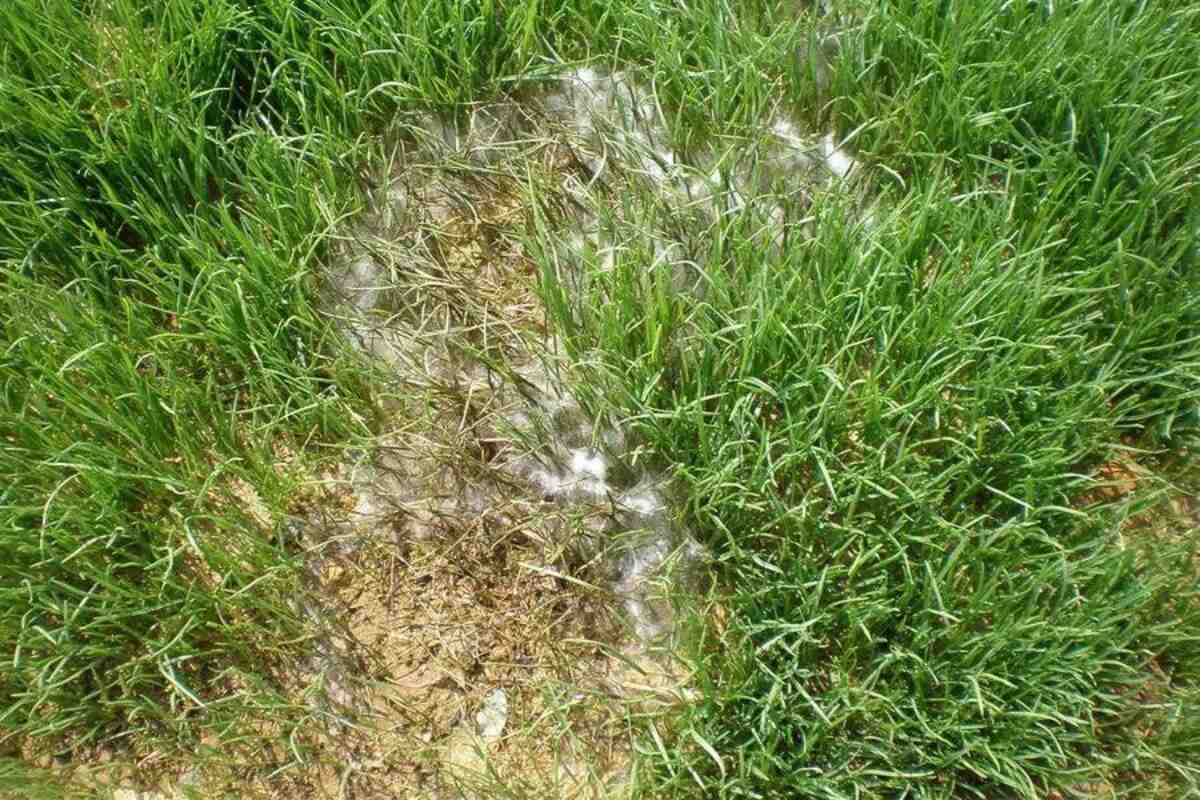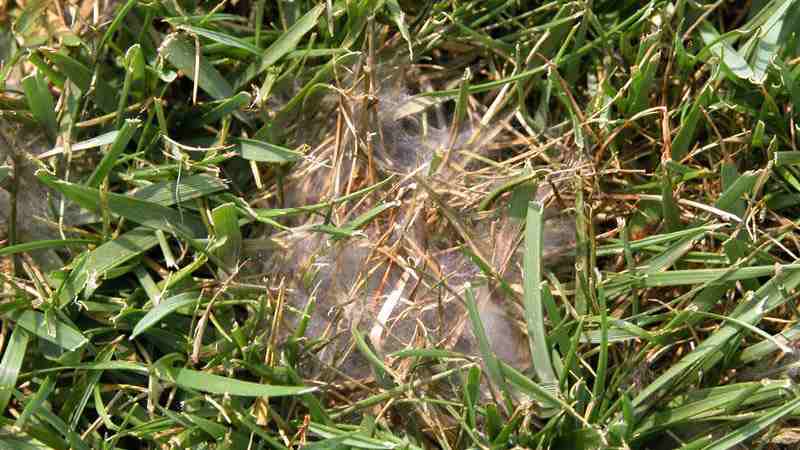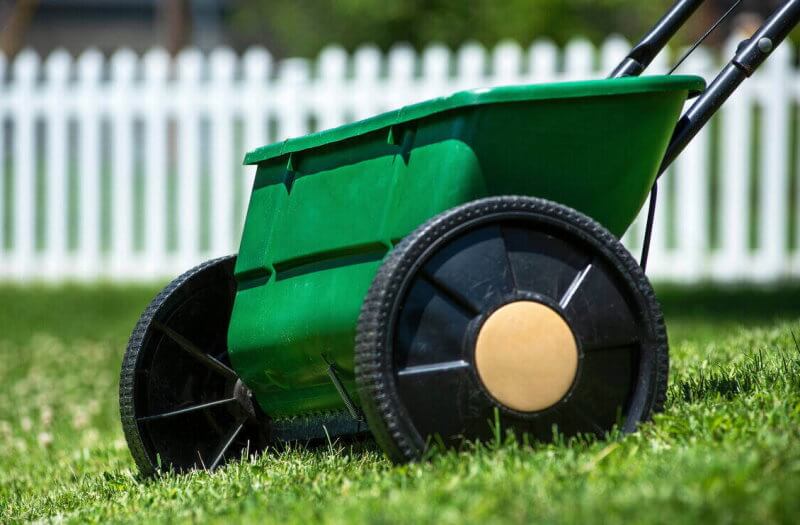
If your lawn has small, recessed patches of grass that look water-soaked, you may have a case of the lawn disease Pythium blight. Depending on your grass type, spots could be dark-colored and irregularly shaped or circular. It is crucial to confirm your grass is infected with Pythium blight ASAP so you can begin fungicide treatments immediately. Lack of treatment can result in the fungus spreading quickly and killing all your grass in a matter of days.
Cloudy, humid, warm weather promotes Pythium blight. Once grass is infected, extreme heat and humidity exacerbate the disease and lead to dead grass. Keep reading to find out more about this ominous organism and how to eliminate it. Even more importantly, find out how to protect your lawn to prevent future infection.
What is Pythium Blight?

Pythium blight is a plant disease caused by parasitic organisms from the genus Pythium. While they behave like fungal lawn diseases, these organisms are not actually classified as fungi. Regardless, they can be devastating for your grass.
Symptoms of Pythium blight in your lawn include:
- Small, sunken circles on the grass with dark green, black, or purple spots
- Grass blades that appear drenched or waterlogged
- Grass that feels oily when you touch it (wash your hands after contact)
- Grass blades covered with a cottony white or gray material, especially in the morning when the grass is wet from the preceding night’s rainfall
- Patches of yellowing or dead, brown grass
The first symptom of Pythium blight you’re likely to notice is patches of grass that look water-soaked or greasy. These patches mark the beginning stages of the disease, and they can spread quickly and kill the grass. Treat your lawn immediately if it is showing signs of or has tested positive for Pythium parasites.
Your grass type determines your lawn’s susceptibility to Pythium pathogens. Cool-season grasses are more vulnerable to Pythium blight. Warm-season grasses are more resistant but can still be infected.
Symptoms of Pythium Blight in Cool-Season Grass: In cool-season grasses, like perennial ryegrass and Kentucky bluegrass, Pythium blight emerges as small recessed, circular patches. The spots can grow from an initial diameter of about 1 to 2 inches to about 1 foot wide. The patches develop in hot, humid weather.
Symptoms of Pythium Blight in Warm-Season Grass: Warm-season grasses, like Zoysiagrass and Bermudagrass, will develop small black or purple spots that can grow into large, irregularly shaped patches. Patches are more likely to grow in humid, overcast, warm weather.
A cottony substance on grass blades in the early morning is an indication that Pythium blight has advanced to a more aggressive stage. This substance, called mycelium, may also appear when grass is wet or in extremely humid conditions. Once the mycelium shows up, your grass will likely wither and dry out, turning yellow and then brown. In this case, grass that has turned brown is already dead.
How to Control Pythium Blight
To find out if your grass is infected, you can send samples of the affected grass to your local cooperative extension laboratory. They will test it for Pythium pathogens. If the grass tests positive, you can kill the pathogens with fungicides, even though they aren’t fungi.
Look for products with the following active ingredients to control Pythium blight:
- Mefenoxam (i.e. Stergo MX Mefenoxam Fungicide (1 Quart) by Atticus)
- Propamocarb (i.e. Advanced Turf Solutions Proplant Fungicide)
- Metalaxyl (i.e. Regulate Select, 1 Gallon Metalaxyl)
To prevent Pythium spp. from building resistance to fungicides, combine products or alternate fungicides with different chemicals.
Preventive fungicide programs are the best management technique. Mefenoxam can be used as a preventive treatment. It should be applied before a lawn is infected. Follow these practices for optimal results:
- Apply in late spring or early summer.
- For a lawn with a history of outbreaks, it may be necessary to apply every 14 days when weather conditions are most prone to promote the disease.
Professional lawn treatment is the best approach for applying fungicides. Here are some reasons why:
- Fungicides contain harsh chemicals and are expensive and difficult to obtain.
- Some fungicides are only available to licensed professionals.
- Lawn fertilization and fungicide application timing can affect whether you make the problem worse or better. The fungus will be severely increased if a fungicide is applied to a fungus-infected lawn after the grass is fertilized with a nitrogen-based fertilizer.
If Pythium blight has already killed sections of your lawn, you can’t bring that grass back from the dead. To fill in those patches and prevent re-infection in the future, overseed the lawn with a turfgrass variety that is resistant to Pythium blight, such as improved Bermudagrass cultivars (for warm-season lawns) or tall fescue (for cool-season lawns).
How to Prevent Pythium Blight

The following cultural practices will keep Pythium blight from taking over your yard:
- Fertilize the Lawn Properly: Use the correct amount of fertilizer at the right intervals, especially in the summer. Pythium blight prefers excessive nitrogen fertility, so if you’re going to use nitrogen-based fertilizers, use slow-releasing options.
- Follow Proper Watering Protocols: The best time to water your grass is in the early morning, as this allows the grass’s foliar surface time to dry. Watering too late at night can cause lingering leaf wetness, which promotes Pythium blight and other lawn diseases. And remember: do not overwater. Hold off on watering the lawn until it begins to show signs of drought stress, such as curling leaf blades or fading color. It will bounce back to normal as soon as you water it.
- Maintain Optimal Calcium Levels: While too much nitrogen fertility can cause Pythium blight, insufficient calcium in the soil can also promote the disease. A soil test will let you know your soil composition. Homeowners can add lime, wood ash, and other calcium-rich soil amendments if they find that their soil is calcium-deficient.
- Mow Grass To Correct Lengths and Mow In the Right Conditions: Cutting grass to the appropriate length keeps it healthy and strong. Proper mowing heights vary for different grass types, so make sure you know the recommendations for your specific lawn. Mow grass when it is dry, as mowing wet grass can promote disease. Clean your mower’s blades and underside after mowing infected grass to keep from spreading the disease.
- Plant Grass Seed Less Vulnerable to Pythium Blight: Although the cool-season turfgrasses Kentucky bluegrass and tall fescue can become infected with Pythium blight, they are more resistant and will incur less damage. For warm-season grass, use Bermudagrass, especially improved cultivars, which have been bred specifically to resist lawn diseases.
- Improve Airflow and Reduce Shade: You can increase your soil’s sunlight exposure and improve air circulation by pruning trees and shrubs.
- Repair Drainage Problems: Overly moist soil promotes outbreaks. Improving soil drainage in low areas and poorly drained areas can reduce the risk of Pythium blight infection, along with many other common lawn diseases.
- Routinely Dethatch and Aerate Your Lawn: Dethatching your lawn clears away thatch accumulation, which is the inevitable build-up of decaying plant matter in your lawn near the soil. Lawn aeration loosens the soil, improving airflow and drainage. When soil is compacted, drains poorly, and is inundated with thatch, it encourages Pythium blight infection.
What Causes Pythium Blight to Infect a Lawn?
The main causes of Pythium blight infection in lawns are:
- Overfertilizing: Although fertilizing the lawn can promote healthy grass, overfertilizing, especially with nitrogen, is one of the major causes of Pythium blight. Always test your soil before fertilizing the lawn to make sure you aren’t adding too much nitrogen.
- Overwatering: Overwatering is the second predominant factor. Pythium pathogens, along with many fungi that cause other lawn diseases, thrive in moist environments. Watering too late in the evening, when the leaves of grass plants aren’t able to dry, can especially create a haven for diseases. Excessive watering can cause Pythium root rot, a more severe condition.
- High Temperatures and Humidity: Hot, humid summers foster Pythium blight and help it spread rapidly. Cool-season grasses are most at risk when temperatures exceed 65° F and daytime temperatures are higher than 86° F. Warm-season grasses are more at risk when nighttime temperatures are above 50° F. Homeowners generally see signs of the disease the morning after a late afternoon or early evening summer thunderstorm.
- Poor Soil Drainage and Air Circulation: Poorly draining soil can lead to outbreaks. Compacted soil, excessive thatch, and grass low in calcium content are breeding grounds for Pythium blight. Home lawns need adequate air circulation to reduce the risk of developing the disease.
- Mowing Infected Grass: Grass infected with Pythium blight is transferred to other lawn areas when the grass is mowed. The disease can also spread when it’s transferred by the soles of shoes.
FAQ About Pythium Blight
What grass types are recommended for overseeding to manage Pythium blight?
Kentucky bluegrass and tall fescue are the best cool-season grasses to overseed your lawn with if it’s suffering from Pythium blight, and improved Bermudagrass cultivars are the best warm-season grasses.
What grass types are most at risk of Pythium blight infection?
Cool-season grasses in general seem to be more vulnerable to Pythium blight than warm-season grasses, and perennial ryegrass seems to be the most susceptible grass type of all.
Does the pH level of the soil affect Pythium blight development?
Yes. It is best to keep the soil slightly acidic. You can do this by adding sulfur or organic mulch, like oak leaves or pine needles. Testing your soil will let you know its pH level and if you need to amend it.
Is there a fungicide that should be avoided?
Most fungicides with Fosetyl-Al are banned for use on home lawns.
When to Call a Lawn Treatment Pro
Pythium blight needs to be treated immediately to keep it from spreading and killing the grass, so you want to make sure you identify it properly. Sometimes, lawn diseases can be difficult to pinpoint. For example, the cottony substance produced by Pythium blight resembles the substance produced by dollar spot. Proper identification is vital because the treatments that work on one disease may not work on another, especially in the case of Pythium blight.
When in doubt, it’s always best to call a lawn care professional to diagnose and treat your lawn’s problems. Finding a licensed, insured, and trusted lawn treatment service in your neighborhood is easier than ever. With LawnStarter’s online and mobile platforms, you can connect with a local pro and get a free quote in minutes.
LawnStarter participates in the Amazon Services LLC Associates Program, an affiliate advertising program. LawnStarter may earn revenue from products promoted in this article.
Main Photo Credit: Pythium spp. / PennState Extension